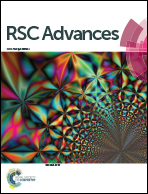Porous boron nitride coupled with CdS for adsorption–photocatalytic synergistic removal of RhB†
Abstract
Porous boron nitride (a-BN) modified by uniformly dispersed CdS photocatalysts was successfully prepared using a facile hydrothermal method, and probed by electron microscopy, X-ray diffraction and UV-vis diffuse reflection spectroscopy. Adsorption and photocatalytic activities were evaluated using high concentration Rhodamine B (RhB) as a target organic pollutant. The results show that after adding a small amount of CdS nanoparticles, the absorbent can self-regenerate with the assistance of visible light irradiation to photocatalytically degrade the organic pollutants adsorbed on the surface of a-BN/CdS. During the adsorption and photocatalytic process, boron nitride could supply a concentrated pollutant environment around CdS photocatalyst active sites. The optimal loading amount of CdS was observed to be 0.5 wt% with the best adsorption–photocatalytic synergistic efficiency, which was probably due to the better dispersion of CdS on a-BN support and the separation of photogenerated electron–hole pairs by negatively charged a-BN. The photocatalytic mechanism of the a-BN/CdS composite was also investigated by radical trapping experiments.


 Please wait while we load your content...
Please wait while we load your content...